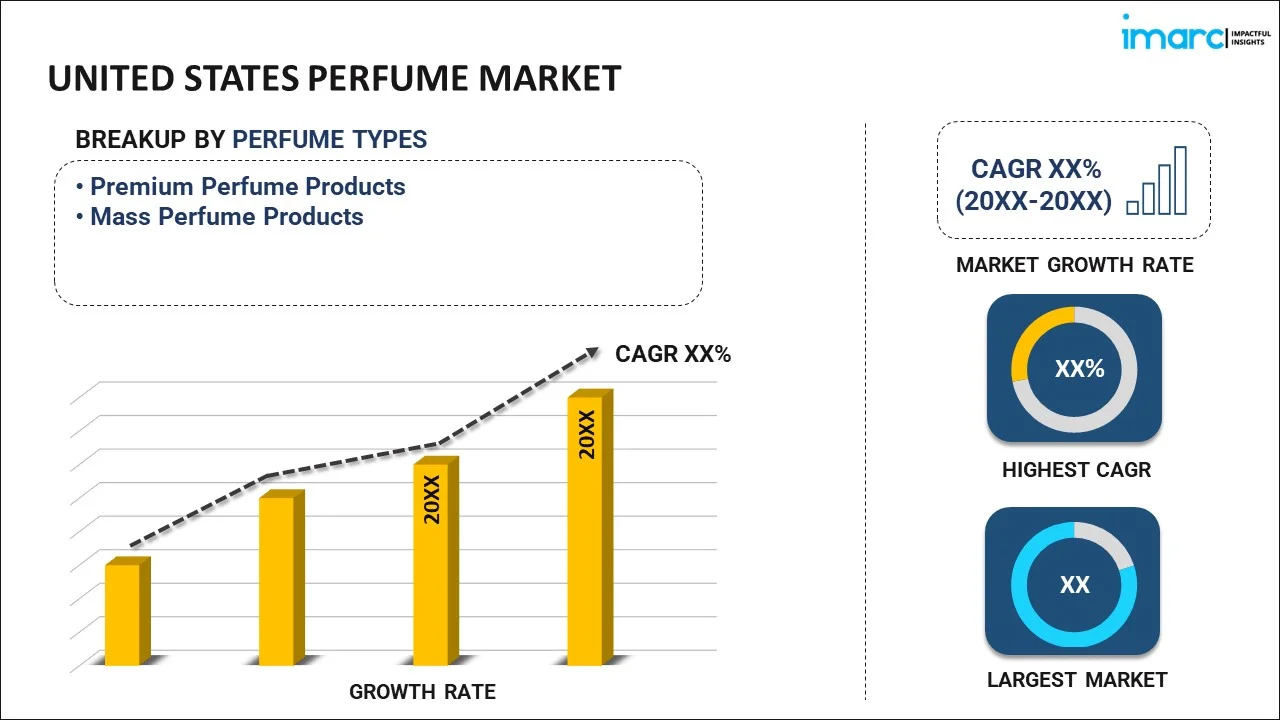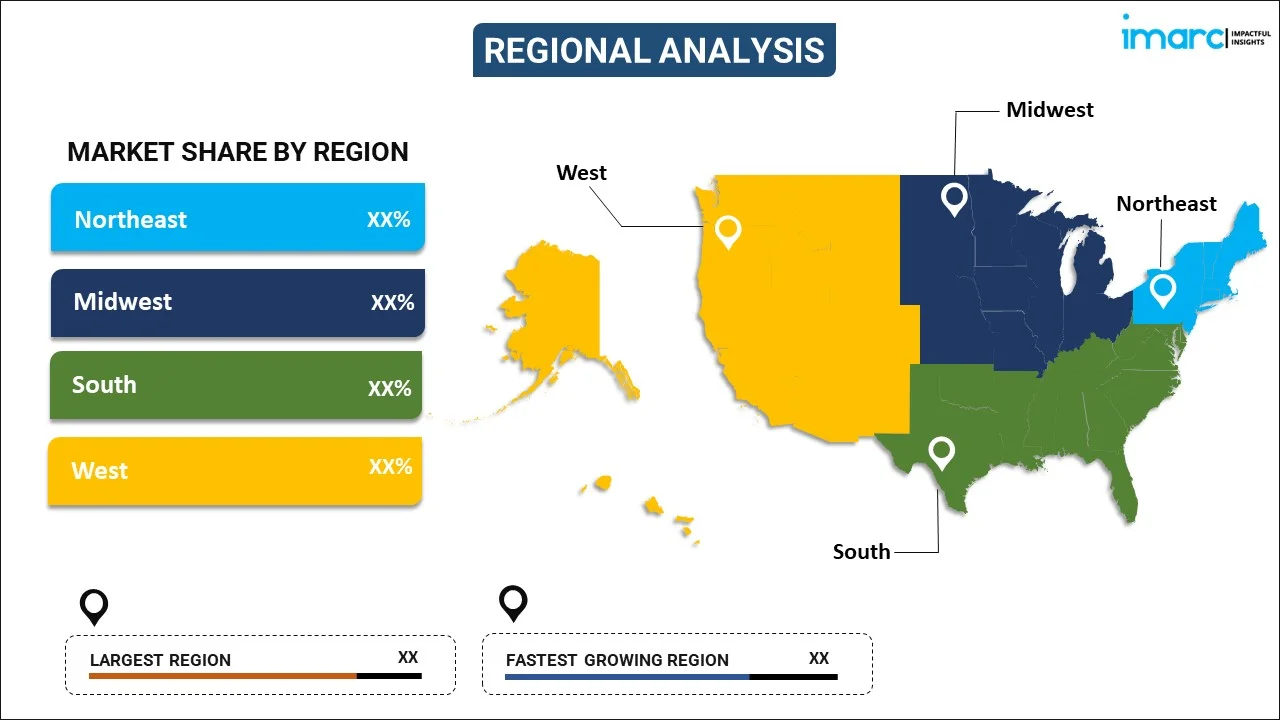
United States Perfume Market Report by Perfume Type (Premium Perfume Products, Mass Perfume Products), Category (Female Fragrances, Male Fragrances, Unisex Fragrances), and Region 2025-2033
Market Overview:
The United States perfume market size reached USD 9.3 Billion in 2024. Looking forward, IMARC Group expects the market to reach USD 18.6 Billion by 2033, exhibiting a growth rate (CAGR) of 8% during 2025-2033. The changing consumer preferences, the growing interest in personal grooming and luxury products, the increasing disposable incomes of the consumers, the rising celebrity endorsements and effective branding strategies, the rapid innovations in fragrance formulations, and the escalating prevalence of online shopping are some of the factors propelling the market.
|
Report Attribute
|
Key Statistics
|
|---|---|
|
Base Year
|
2024 |
|
Forecast Years
|
2025-2033
|
|
Historical Years
|
2019-2024
|
| Market Size in 2024 | USD 9.3 Billion |
| Market Forecast in 2033 | USD 18.6 Billion |
| Market Growth Rate (2025-2033) | 8% |
A perfume is a fragrant liquid composed of a mixture of essential oils, aroma compounds, and solvents designed to impart a pleasant and distinctive scent to the body, objects, or living spaces. Derived from the Latin term "per fumum," meaning "through smoke," perfumes have a rich history dating back centuries, evolving from aromatic substances burned for their fragrant qualities. In modern times, perfumes are meticulously crafted through a combination of natural and synthetic ingredients, each carefully selected to create a harmonious and enduring fragrance. These scented concoctions are typically categorized into different notes top, middle, and base that unfold over time, revealing a complex aromatic profile. Perfumes serve as a form of self-expression, reflecting personal style and preferences, and are often associated with memories and emotions. Packaged in ornate bottles, perfumes are a coveted accessory, embodying a sensory journey that intertwines artistry, chemistry, and the essence of individual identity.
United States Perfume Market Trends:
The market in the United States is primarily driven by the increasing emphasis on personal grooming and self-expression. As consumers in the United States place growing importance on individuality and personal style, the demand for a diverse range of perfumes has accelerated. The industry has responded by offering a wide array of fragrances catering to different tastes and occasions, ranging from classic and timeless scents to innovative and niche offerings. Furthermore, the rising influence of celebrity endorsements and collaborations with well-known personalities also plays a significant role in the market. Many celebrities partner with fragrance brands to create signature scents, leveraging their star power to drive consumer interest and sales. This trend aligns with the American culture of celebrity fascination and the desire to emulate the lifestyles of admired figures. Besides, the escalating disposable income among consumers in the United States contributes to the growth of the perfume market. With increased purchasing power, individuals are more willing to invest in premium and luxury fragrances. The market has responded by introducing a variety of high-end and niche perfumes, attracting a segment of consumers seeking exclusivity and quality. Moreover, the growing influence of e-commerce and online retail channels is fueling the market. The convenience of shopping online, coupled with a wide range of product choices, has fueled the popularity of purchasing perfumes through digital platforms. Many fragrance brands have established a strong online presence, providing consumers with easy access to their products and contributing to overall market growth. Additionally, the market benefits from continuous innovation in fragrance formulations and packaging. Perfume brands constantly explore new ingredients, extraction methods, and creative packaging designs to capture consumer attention and meet evolving preferences. The introduction of sustainable and eco-friendly practices in the perfume industry also resonates with environmentally conscious consumers in the United States, further driving market growth.
United States Perfume Market Segmentation:
IMARC Group provides an analysis of the key trends in each segment of the market, along with forecasts at the country level for 2025-2033. Our report has categorized the market based on perfume type and category.
Perfume Type Insights:

- Premium Perfume Products
- Mass Perfume Products
The report has provided a detailed breakup and analysis of the market based on the perfume type. This includes premium perfume products and mass perfume products.
Category Insights:
- Female Fragrances
- Male Fragrances
- Unisex Fragrances
A detailed breakup and analysis of the market based on the category have also been provided in the report. This includes female fragrances, male fragrances, and unisex fragrances.
Regional Insights:

- Northeast
- Midwest
- South
- West
The report has also provided a comprehensive analysis of all the major regional markets, which include Northeast, Midwest, South, and West.
Competitive Landscape:
The market research report has also provided a comprehensive analysis of the competitive landscape in the market. Competitive analysis such as market structure, key player positioning, top winning strategies, competitive dashboard, and company evaluation quadrant has been covered in the report. Also, detailed profiles of all major companies have been provided.
United States Perfume Market Report Coverage:
| Report Features | Details |
|---|---|
| Base Year of the Analysis | 2024 |
| Historical Period | 2019-2024 |
| Forecast Period | 2025-2033 |
| Units | Billion USD |
| Scope of the Report | Exploration of Historical and Forecast Trends, Industry Catalysts and Challenges, Segment-Wise Historical and Predictive Market Assessment:
|
| Perfume Types Covered | Premium Perfume Products, Mass Perfume Products |
| Categories Covered | Female Fragrances, Male Fragrances, Unisex Fragrances |
| Regions Covered | Northeast, Midwest, South, West |
| Customization Scope | 10% Free Customization |
| Post-Sale Analyst Support | 10-12 Weeks |
| Delivery Format | PDF and Excel through Email (We can also provide the editable version of the report in PPT/Word format on special request) |
Key Questions Answered in This Report:
- How has the United States perfume market performed so far and how will it perform in the coming years?
- What has been the impact of COVID-19 on the United States perfume market?
- What is the breakup of the United States perfume market on the basis of perfume type?
- What is the breakup of the United States perfume market on the basis of category?
- What are the various stages in the value chain of the United States perfume market?
- What are the key driving factors and challenges in the United States perfume?
- What is the structure of the United States perfume market and who are the key players?
- What is the degree of competition in the United States perfume market?
Key Benefits for Stakeholders:
- IMARC’s industry report offers a comprehensive quantitative analysis of various market segments, historical and current market trends, market forecasts, and dynamics of the United States perfume market from 2019-2033.
- The research report provides the latest information on the market drivers, challenges, and opportunities in the United States perfume market.
- Porter's five forces analysis assist stakeholders in assessing the impact of new entrants, competitive rivalry, supplier power, buyer power, and the threat of substitution. It helps stakeholders to analyze the level of competition within the United States perfume industry and its attractiveness.
- Competitive landscape allows stakeholders to understand their competitive environment and provides an insight into the current positions of key players in the market.
Need more help?
- Speak to our experienced analysts for insights on the current market scenarios.
- Include additional segments and countries to customize the report as per your requirement.
- Gain an unparalleled competitive advantage in your domain by understanding how to utilize the report and positively impacting your operations and revenue.
- For further assistance, please connect with our analysts.
 Request Customization
Request Customization
 Speak to an Analyst
Speak to an Analyst
 Request Brochure
Request Brochure
 Inquire Before Buying
Inquire Before Buying




.webp)




.webp)












